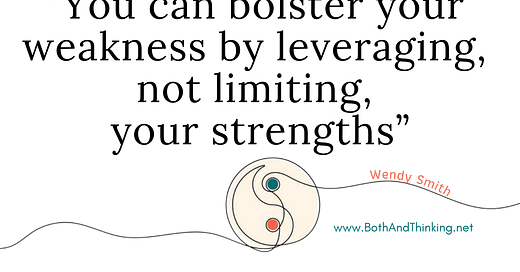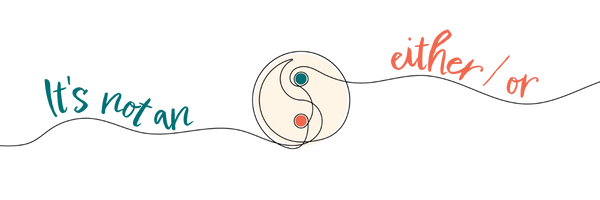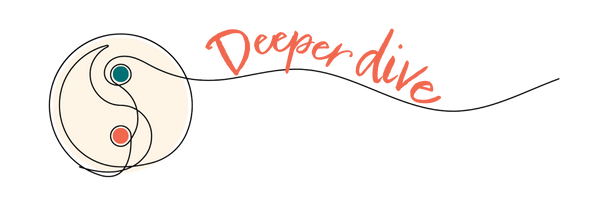Jiu-Jitsu Leadership: Leverage Your Strengths to Make Space for Difference
Instead of dialing down your dominant strengths, what if you used them to lift up what’s missing?
The other day, I caught myself telling my daughter, “Just focus and get it done.” It was one of those parenting lines that slips out before you can think. It was well-worn, efficient, and missed the moment. Later, I realized I’d sidelined what she really needed - a chance to feel seen as she navigated the stress of theatre tech week. My default mode of productivity and efficiency crowded out my empathy for her experiences.
I see myself as someone who can balance performance with empathy, accomplishment with connection, task with process. But when something matters to me—whether it’s a parenting issue, or more likely a work project - the external pressure for achievement and my dominant internal drive to ‘just do it’ often win out. That strength works… until it doesn’t… and starts pushing out other things that matter just as much: connection, creativity, patience, play.
You may have found this same experience in your life or leadership. You seek balance across competing demands, but become overwhelmed by the dominant force. Short-term work demands might be crowding out long-term goals. Stress and anxieties might hijack your brain and prevent you from feeling grateful and present in the moment. At work, competitive, short-term thinking might crowd out interests in collaborative partnership, sustainable products, and deliberate discourse. It’s hard to seek out a both/and when there’s so much pressure on only one side.
I used to think the solution was to reign in my dominant mode, quieting the part of me that’s so focused on outcomes to allow more space for the empathetic listening. But my recent research with coauthors Natalie Slawinski and Connie Van der Byl offers a different solution. We find that the answer isn’t to tone down what’s strong, but to leverage it. Instead of rejecting the energy of one force, redirect it.
That strategy worked to get competitive energy companies to cooperatively work to minimize their collective impact on the earth. We describe it as the jiu-jitsu strategy - leaning into, instead of resisting, your opponent’s energy. And it can be a valuable tool to help us find more balance and effectiveness in life and leadership.
Want to use your strengths to find more balance? Here’s some tips to do so.
“You can bolster your weakness be leveraging, not limiting, your strengths” - Wendy Smith
In our recent research, my colleagues and I studied a group of environmental champions, led by Gordon Lambert, inside COSIA, the Canadian Oil Sands Innovation Alliance (now part of Pathways Alliance). These leaders faced what looked like an impossible paradox: how to build a collaborative alliance to advance bold environmental goals inside an industry dominated by profit pressures and short-term returns. Instead of fighting the dominant business logic, they used it. They framed sustainability as a business advantage, something that would reduce risk, cut costs, improve reputation, and enable long-term growth. This wasn’t selling out. It was jiu-jitsu: using the power of what’s already moving to make space for something new.
What they taught us has broad implications for leadership. We all have strategies informed by internal preferences and external pressures that dominant our approaches. Instead of trying to mute these strategies, our research shows us how to leverage them.
1. Start with What You Know to Build Trust
When you’re navigating competing demands, it can feel tempting to leap straight into what’s missing—to champion the overlooked value, advocate for the underdog, or challenge the status quo. But change often sticks best when it starts from familiarity. In our research on COSIA, we saw how leaders grounded their environmental efforts in business logic—not because they didn’t care about the planet, but because they knew that starting with profit would build trust. It was a shared language, a familiar foundation. This principle doesn’t just apply to organizations, it applies to ourselves, too. When you feel torn between competing values, begin with the one that feels most natural to you. If you're wired for achievement, use that as the path into deeper connection. If you're anchored in care and empathy, use that to reach toward courageous action. Starting with what you know and what others recognize builds psychological safety—it says, “I see you, I get this, we’re on familiar ground.” And from that place, it becomes easier to invite in what’s new, different, or even uncomfortable. Trust creates the opening. Familiarity creates the bridge.
2. Clarify the Bigger Goal That Brings It All Together
When you’re navigating competing demands, clarity about your larger purpose is what helps everything click into place. In our research at COSIA, the environmental champions weren’t just trying to push green initiatives into an oil-driven industry. They were focused on something much bigger: the long-term sustainability of their companies, their communities, and the planet. And they recognized something critical, that achieving that goal enabled the industry to maintain its social license to operate. In other words, if oil sands companies didn’t take environmental responsibility seriously, they risked losing public trust, investor confidence, and ultimately, the ability to continue doing business.
When you zoom out to see the bigger goal, you start to realize that the dominant goal, the strength that often feels overwhelming or one-sided, doesn’t have to be the problem. It can be part of the solution. That’s what COSIA leaders discovered. Profit wasn’t the enemy of environmental progress. It was the entry point. By aligning sustainability with business interests, they were able to bring environmental practices into the center of industry conversations. They didn’t abandon the dominant logic, they leveraged it. And that’s the move. When you’re clear on what you’re ultimately trying to achieve, you can stop treating your strengths and weaknesses as opposites. You can use what’s powerful to lift up what’s at risk. That’s the paradoxical power of purpose: it turns tension into traction. It invites strength to make space for what’s been missing, not by replacing it, but by expanding what’s possible.
3. Let Strength Support What Feels Weak
When something matters to us such as inclusion, well-being, or sustainability, but it feels undervalued in the systems we’re part of, it’s easy to try to elevate it by downplaying what’s already strong. But what if, instead, we let the dominant strength carry the other value forward? In our research on COSIA, leaders figured out how to use competitive practices to inform environmental outcomes. COSIA leaders set up competition to enhance environmentalism, leaned into peer pressures, and made sure that sustainability goals enabled long-term competitive advantage. In the same way, if your team worships performance, rest doesn’t have to be framed as a “nice to have”, it can be redefined as the tool to enhance performance. If your culture prizes speed, reflection can be offered as the key to smarter decisions. We can go slow to go fast. When strength uplifts weakness, we don’t have to choose, we grow the capacity for both.
Want to read more… you can check out the following research.
Leveraging the Dominant Pole: How Champions of an Industry-Wide Environmental Alliance Navigate Coopetition Paradoxes. Here’s a link to our paper on COSIA.
Short on time: Intertemporal tensions in business sustainability - My co-author Natalie Slawinski and Pratima Bansal also explored the power of long-term goals in the Canadian Oil Sands:
I look forward to connecting. Here’s what I have coming up.
April 8 - Yale, New Haven CT. I’m thrilled to be returning to my alma mater to give a talk at the Yale School of Management. You might also spot me grabbing a vegan treat at the classic Claire’s Corner Copia!
College Visits - The rest of April and early May are reserved for college visits as my two high school seniors decide where their next phase of life will bring them












